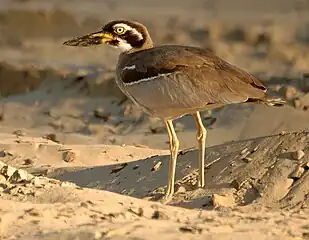| Stone-curlews Temporal range: Late Oligocene to present | |
|---|---|
.jpg.webp) | |
| Bush stone-curlew, Burhinus grallarius | |
| Scientific classification | |
| Domain: | Eukaryota |
| Kingdom: | Animalia |
| Phylum: | Chordata |
| Class: | Aves |
| Order: | Charadriiformes |
| Suborder: | Chionidi |
| Family: | Burhinidae Mathews, 1912 |
| Genera | |
| |
 | |
| modern range | |
The stone-curlews, also known as dikkops or thick-knees, consist of 10 species within the family Burhinidae, and are found throughout the tropical and temperate parts of the world, with two or more species occurring in some areas of Africa, Asia, and Australia. Despite the group being classified as waders, most species have a preference for arid or semiarid habitats.
Taxonomy
The family Burhinidae was introduced in 1912 for the stone-curlews by Australian ornithologist Gregory Mathews.[1][2] The family contains three genera: Hesperoburhinus, Burhinus and Esacus.[3] The name Burhinus combines the Ancient Greek bous meaning "ox" and rhis, rhinos meaning "nose" (or "bill").[4]
Molecular phylogenetic studies have shown that the family Burhinidae is sister to a clade containing the sheathbills in the family Chionidae and the Magellanic plover in its own family Pluvianellidae. The stone-curlews are not closely related to the curlews, genus Numenius, that belong to the sandpiper family Scolopacidae.[5]
Description
They are medium to large birds with strong black or yellow black bills, large yellow eyes—which give them a reptilian appearance—and cryptic plumage. The names thick-knee and stone-curlew are both in common use. The term stone-curlew owes its origin to the broad similarities with true curlews. Thick-knee refers to the prominent joints in the long yellow or greenish legs and apparently originated with a name coined in 1776 for B. oedicnemus, the Eurasian stone-curlew. Obviously the heel (ankle) and the knee are confused here.[6]
Behaviour
They are largely nocturnal, particularly when singing their loud, wailing songs, which are reminiscent of true curlews.[7] Their diet consists mainly of insects and other invertebrates. Larger species also take lizards and even small mammals.[7] Most species are sedentary, but the Eurasian stone-curlew is a summer migrant in the temperate European part of its range, wintering in Africa.
Species
A fossil genus Wilaru, described from the Late Oligocene to the Early Miocene of Australia, was originally classified as a stone-curlew, but was subsequently argued to be a member of the extinct anseriform family Presbyornithidae, instead.[8] The living species are:
| Picture | Name | Binomial name |
|---|---|---|
 |
Double-striped thick-knee | Hesperoburhinus bistriatus |
%252C_crop.jpg.webp) |
Peruvian thick-knee | Hesperoburhinus superciliaris |
%252C_crop.jpg.webp) |
Eurasian stone-curlew | Burhinus oedicnemus |
.jpg.webp) |
Indian stone-curlew | Burhinus indicus |
%252C_crop.jpg.webp) |
Senegal thick-knee | Burhinus senegalensis |
 |
Water thick-knee | Burhinus vermiculatus |
 |
Spotted thick-knee | Burhinus capensis |
 |
Bush stone-curlew | Burhinus grallarius (formerly B. magnirostris, the bush thick-knee). |
 |
Great stone-curlew | Esacus recurvirostris |
 |
Beach stone-curlew | Esacus magnirostris |
References
- ↑ Mathews, Gregory (1912). "A reference-list to the birds of Australia". Novitates Zoologicae. 18 (3): 171-455 [225].
- ↑ Bock, Walter J. (1994). History and Nomenclature of Avian Family-Group Names. Bulletin of the American Museum of Natural History. Vol. Number 222. New York: American Museum of Natural History. pp. 112–113, 137, 247.
- ↑ Gill, Frank; Donsker, David; Rasmussen, Pamela, eds. (January 2021). "Buttonquail, thick-knees, sheathbills, plovers, oystercatchers, stilts, painted-snipes, jacanas, Plains-wanderer, seedsnipes". IOC World Bird List Version 11.1. International Ornithologists' Union. Retrieved 29 May 2021.
- ↑ Jobling, James A. (2010). The Helm Dictionary of Scientific Bird Names. London: Christopher Helm. p. 81. ISBN 978-1-4081-2501-4.
- ↑ Kuhl, H.; Frankl-Vilches, C.; Bakker, A.; Mayr, G.; Nikolaus, G.; Boerno, S.T.; Klages, S.; Timmermann, B.; Gahr, M. (2020). "An unbiased molecular approach using 3′-UTRs resolves the avian family-level tree of life". Molecular Biology and Evolution (msaa191). doi:10.1093/molbev/msaa191. PMC 7783168.
- ↑ Kochan, Jack B. (1994). Feet & Legs. Birds. Mechanicsburg: Stackpole Books. ISBN 0-8117-2515-4.
- 1 2 Harrison, Colin J.O. (1991). Forshaw, Joseph (ed.). Encyclopaedia of Animals: Birds. London: Merehurst Press. pp. 105–106. ISBN 1-85391-186-0.
- ↑ Vanesa L. De Pietri; R. Paul Scofield; Nikita Zelenkov; Walter E. Boles & Trevor H. Worthy (2016). "The unexpected survival of an ancient lineage of anseriform birds into the Neogene of Australia: the youngest record of Presbyornithidae". Royal Society Open Science. 3 (2): 150635. doi:10.1098/rsos.150635. PMC 4785986. PMID 26998335.
External links
- Thick-knees videos on the Internet Bird Collection